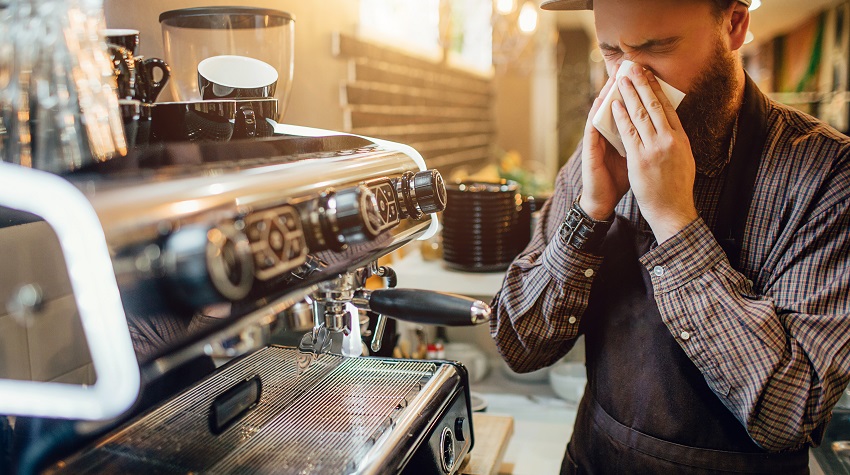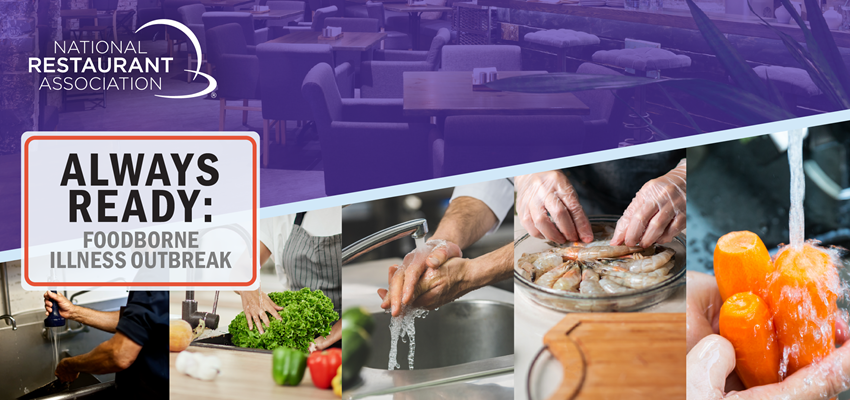Articles
August 01, 2024
Strict sick leave policy is critical to your operation’s food safety
CDC says large percentage of foodborne illness outbreaks are preventable by making sure sick employees don’t come to work.

The Food Code spells out when the restaurant is responsible for reporting employees with symptoms.
Every year, one in six Americans, about 48 million of us, comes down with a case of foodborne hospitalizing about 128,000 and causing about 3,000 deaths. illness, according to the Centers for Disease Control and Prevention (CDC).
As many as 40% of these foodborne illness outbreaks are caused through contamination by a restaurant employee who’s sick, the CDC says. Data collected by CDC’s National Environmental Assessment Reporting System (NEARS) from 25 state and local health departments from 2017 to 2019 showed a total of 800 foodborne illness outbreaks associated with 875 retail food establishments (which include groceries, C-stores and others in addition to restaurants and foodservice outlets).
The common denominator in 320 of these outbreaks, according to the report, was an infectious employee. Norovirus, the most common cause of foodborne illness, was confirmed or suspected in 47% of outbreaks. Salmonella was the second-most-common cause, accounting for just under 19% of cases. While these statistics may have changed due to greater food safety awareness following the COVID-19 pandemic, they’re the most recent figures available.
The 2022 FDA Food Code is a good place to start when adopting a written sick leave policy. Section 2-2, “Employee Health,” outlines the criteria, including symptoms and specific diagnoses, that would prevent an employee from handling food and/or prep equipment, or even coming to work. For example, an employee with a cough or runny nose should be restricted from working with exposed food, utensils and equipment. An employee experiencing vomiting, diarrhea or jaundice should not come to work at all until cleared by a health practitioner.
The Food Code also spells out when the restaurant is responsible for reporting employees with symptoms. Reportable symptoms, for example, include vomiting, diarrhea, jaundice, sore throat with fever, and a lesion containing pus such as a boil or infected wound that is open or draining. Reportable diagnoses include norovirus, hepatitis A virus, shigella spp., Shiga toxin-producing E. coli, typhoid fever (caused by salmonella typhi), or salmonella (nontyphoidal). Restaurants also are responsible for reporting an employee’s history of exposure to these diseases.
Research has shown that implementing a policy and managing sick employees is more effective and simpler when you put these procedures in place:
As many as 40% of these foodborne illness outbreaks are caused through contamination by a restaurant employee who’s sick, the CDC says. Data collected by CDC’s National Environmental Assessment Reporting System (NEARS) from 25 state and local health departments from 2017 to 2019 showed a total of 800 foodborne illness outbreaks associated with 875 retail food establishments (which include groceries, C-stores and others in addition to restaurants and foodservice outlets).
The common denominator in 320 of these outbreaks, according to the report, was an infectious employee. Norovirus, the most common cause of foodborne illness, was confirmed or suspected in 47% of outbreaks. Salmonella was the second-most-common cause, accounting for just under 19% of cases. While these statistics may have changed due to greater food safety awareness following the COVID-19 pandemic, they’re the most recent figures available.
Check out the FDA’s interactive Employee Health Policy Tool to help operators prevent transmission of foodborne illnesses.
The simple solution would seem to be a strict (and enforceable) sick leave policy. However, three other studies by the Environmental Health Specialists Network (EHS-Net), a collaboration of federal, state, and local environmental health specialists, turned up gaps in the way restaurants manage sick workers.- Restaurants need a written sick policy and those policies need to list symptoms that should keep employees from working.
- Employees—and managers—work when sick for a variety of reasons. Sick leave policies need to address those reasons when possible.
- Managers let sick employees decide whether to work. They should be more proactive in determining if an employee has symptoms that could cause a foodborne illness.
- Restaurants typically scramble when trying to replace a sick employee. Managers need to take a more proactive approach to scheduling.
Why sick employees work
There are a number of social, financial, and personal reasons why employees work even when they’re not feeling well, among them:- Financial insecurity and fear of losing their job.
- A strong work ethic or sense of duty, and a desire not to leave the restaurant or co-workers short-staffed.
- Not feeling very sick or thinking they won’t infect anyone else.
- Not having a clear understanding of the restaurant’s sick leave policy.
A clear written policy
If you don’t already have one, you should develop a clearly written policy for employees on when to call in sick.The 2022 FDA Food Code is a good place to start when adopting a written sick leave policy. Section 2-2, “Employee Health,” outlines the criteria, including symptoms and specific diagnoses, that would prevent an employee from handling food and/or prep equipment, or even coming to work. For example, an employee with a cough or runny nose should be restricted from working with exposed food, utensils and equipment. An employee experiencing vomiting, diarrhea or jaundice should not come to work at all until cleared by a health practitioner.
The Food Code also spells out when the restaurant is responsible for reporting employees with symptoms. Reportable symptoms, for example, include vomiting, diarrhea, jaundice, sore throat with fever, and a lesion containing pus such as a boil or infected wound that is open or draining. Reportable diagnoses include norovirus, hepatitis A virus, shigella spp., Shiga toxin-producing E. coli, typhoid fever (caused by salmonella typhi), or salmonella (nontyphoidal). Restaurants also are responsible for reporting an employee’s history of exposure to these diseases.
Making a policy work
A written sick leave policy will protect your staff, your customers and your restaurant only if it’s enforced. However, managers and employees shouldn’t think of it as punishment, but as part and parcel of your food safety program, one designed to prevent outbreaks and protect everyone’s health and livelihood.Research has shown that implementing a policy and managing sick employees is more effective and simpler when you put these procedures in place:
- Managers proactively ask employees who call in sick to describe their symptoms and decide together with employees whether it’s safe to work.
- Restaurants clearly communicate to all employees, including managers, that taking sick leave will not result in the loss of their jobs.
- Restaurants create a system where employees take turns being scheduled “on call” to fill in when other workers become ill. It’s imperative that the system include both front- and back-of-the-house employees.
Get the report
Get the report
Sign up for our Newsletter
The latest news from the National Restaurant Association, published every other Thursday
By clicking Submit I agree to receive email communications from the National Restaurant Association and agree to our Privacy Policy(Opens in a new window).
